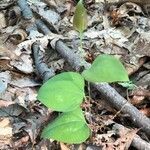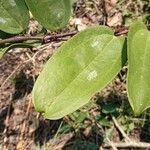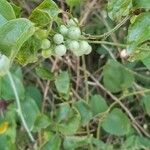Vines; rhizomes tuberous, or spinose, linear. Stems perennial, climbing, branching, green, often mottled, terete, to 5+ m, woody, glaucous, glabrous; prickles, when present, thin, 1–5 mm. Leaves deciduous to semi evergreen, ± evenly disposed; petiole 0.5–1.5 cm; blade green to glaucous-green, often mottled adaxially, silvery grayish abaxially, drying to brownish tan adaxially, broadly ovate, elliptic to reniform, with 3 (or 5) conspicuous veins, 4.5–11 × 2.5–6.6 cm, glabrous and glaucous abaxially, base truncate, subcordate, or attenuate, margins entire, apex rounded, tapering, or short-acuminate. Umbels few to many, axillary to leaves, 5–12+-flowered, open, umbellate to hemispherical; peduncle 2–5 cm. Flowers: perianth yellow to bronze; tepals 3–7 mm; anthers longer than filaments; ovule 1 per locule; pedicel 0.5–1 cm. Berries blue to black, subglobose, 8–10 mm, shiny black at maturity, glaucous. 2n = 28, 32.
More
Slender woody vine, seldom climbing very high; stems green and glaucous the first year, beset with stout prickles, the lower generally straight, the upper nodal and recurved; lvs often ± persistent, mostly ovate, often with cordate base, varying to subrotund or nearly triangular, 5–9 cm, half to three-fourths as wide, glaucous (and often long-papillate) beneath, at maturity subcoriaceous and shining above, thin and entire at the margin, 3-or 5(7)-nerved, the reticulate veins not prominently elevated; peduncles flattened, 1.5–3 times as long as the petioles; fr black, glaucous, 8–10 mm, mostly 2-or 3-seeded; 2n=32. Upland woods, roadsides, and thickets; Conn. to Fla., w. to O., s. Ill., se. Mo., Ark., and Tex. May, June.
Dry to wet woods, thickets, hedge-rows, roadsides; at elevations from sea level to 800 metres. Dry to moist sandy thickets, open woods and fields.




